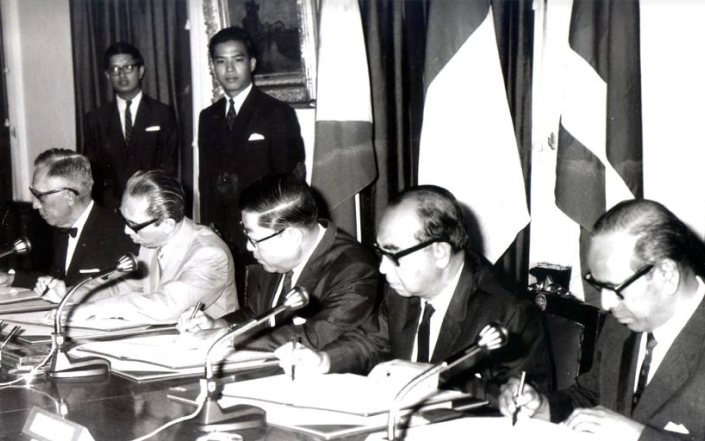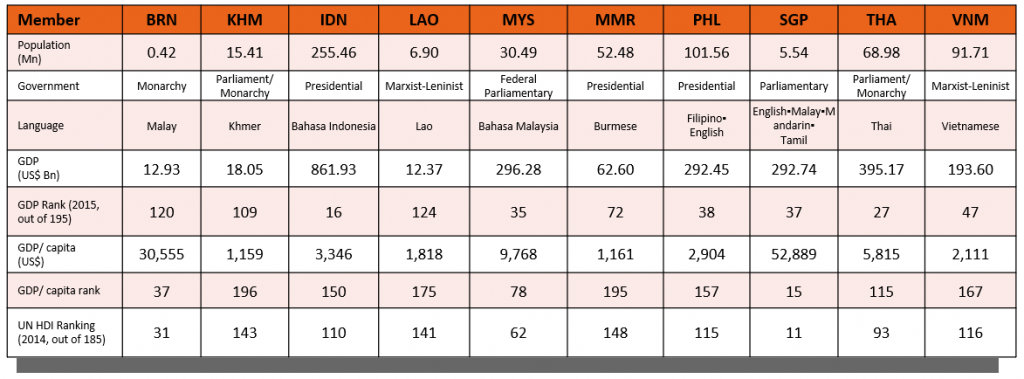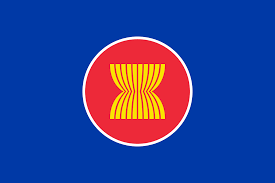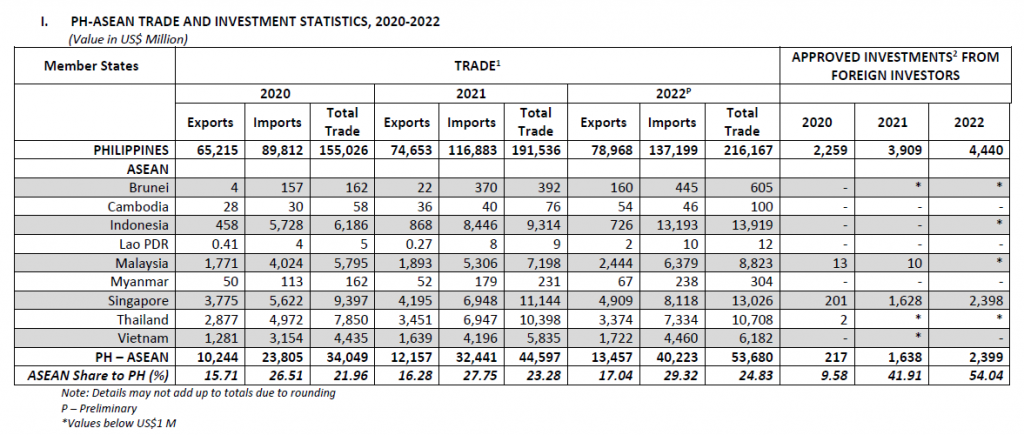The Association of Southeast Asian Nations

What is ASEAN?

The Association of Southeast Asian Nations (ASEAN) is a regional intergovernmental organization created to facilitate economic growth, social progress, cultural development, peace, and stability, and to promote regional cooperation and integration in Southeast Asia. The vision of ASEAN is centered around the idea of a cohesive, peaceful, stable, and resilient region with shared prosperity.
The significance of ASEAN lies in its ability to bring together diverse nations to work towards common goals and address regional challenges collectively. This regional intergovernmental organization has not only been pivotal in promoting political and security cooperation but also in facilitating economic integration and collaboration among its members.
ASEAN aims to create a single market and production base within the region through the ASEAN Economic Community (AEC), which is designed to allow the free flow of goods, services, investment, skilled labor, and a freer flow of capital.
Brief History of ASEAN

Signing of the Bangkok Declaration
Alternate text: Foreign Ministers of Indonesia, Malaysia, the Philippines, Singapore and Thailand signing the Bangkok Declaration, thereby creating ASEAN
ASEAN was established on August 8, 1967, in Bangkok, Thailand, with the signing of the ASEAN Declaration, also known as the Bangkok Declaration, by the founding fathers of ASEAN: Indonesia, Malaysia, Philippines, Singapore, and Thailand.
Brunei Darussalam joined ASEAN on January 7, 1984, followed by Viet Nam on July 28, 1995, Lao PDR and Myanmar on July 23, 1997, and Cambodia on April 30, 1999, making up what is
today the ten Member States of ASEAN. In 2022, ASEAN granted Timor Leste Observer Status and work is underway for their accession as a Member State.
The creation of ASEAN stemmed from the recognition of the need for regional cooperation to ensure stability and prevent the uncertainty looming over the region. The founding members engaged in informal and goodwill-filled negotiations in Bang Saen, employing a novel approach to diplomacy, later known as “sports-shirt diplomacy.” This led to the establishment of ASEAN, underlining the importance of unity for the economic and social growth of Southeast Asia, opposing the fragmentation and dependency on industrial nations.
The Bangkok Declaration laid the groundwork for ASEAN’s inclusive and gradual approach towards regional dialogue, cooperation, and integration. The founding fathers foresaw a community that was open to all Southeast Asian states, aspiring for a stable and prosperous region free from external domination. Over the years, ASEAN expanded its membership and adopted several formal agreements, solidifying its role in regional and broader Asia Pacific community-building.
ASEAN Diversity

The beauty of ASEAN is that it brings together some of the most diverse countries in the world. It is an association of 10 nations that vary widely in terms of economic development, political systems, cultures, religions, languages, and ethnicities. This diversity makes ASEAN a highly varied region.
Despite these differences, ASEAN has succeeded in fostering a spirit of unity and cooperation among its member states, showcasing a remarkable example of regional integration.

A symbol of this unity in diversity is exemplified by the ASEAN emblem, which represents the collective identity and solidarity of the ASEAN member states.
The flag features a circle of ten paddy or rice stalks, symbolizing the dream of ASEAN’s Founding Fathers for an ASEAN comprising all ten countries in Southeast Asia bound together in friendship and solidarity.
The circle represents the unity of ASEAN, while the blue color symbolizes peace and stability, red represents courage and dynamism, white shows purity, and yellow signifies prosperity.
The flag is not just a visual emblem but a powerful reminder of the region’s commitment to moving forward together in unity and strength, despite the diverse backgrounds of its members.
ASEAN Consensus
This community is built on the principle of consensus, which has been the cornerstone of ASEAN’s decision-making process. This approach has enabled ASEAN members to stay united in regional cooperation, overcoming challenges and leveraging opportunities despite the vast diversity among them. The consensus model ensures that all member states have a voice in the decision- making process, contributing to a sense of ownership and commitment towards the collective goals and initiatives of ASEAN.
The ASEAN Economic Community
**The AEC**
The ASEAN Economic Community (AEC), established in 2015, represents the realization of the region’s end goal of economic integration. It embodies ASEAN’s commitment to creating a single market and production base, which is competitive, equitable, and fully integrated into the global economy. The AEC envisions an ASEAN region without trade barriers, where goods, services, investment, and skilled labor can move freely among member states.
The primary objectives of the AEC are to achieve a single market and production base, increase competitiveness, promote equitable economic development, and further integrate ASEAN into the global economy. The AEC Blueprint 2025, which follows the initial blueprint, outlines the strategic measures under various pillars to achieve these objectives. These pillars include:
- A highly integrated and cohesive economy
- A competitive, innovative, and dynamic ASEAN
- Enhanced connectivity and sectoral cooperation
- A resilient, inclusive, people-oriented, and people-centred ASEAN
- A global ASEAN
The framework focuses on key sectors such as trade, services, investment, and skilled labor, aiming to simplify and harmonize trade regulations, standards, and procedures across ASEAN members.
The AEC has significantly advanced regional economic integration, creating a region with a combined GDP that ranks as one of the largest economies in the world. It has enhanced ASEAN’s trade and investment flows, both within the region and with the rest of the world, contributing to increased economic dynamism. The integration efforts have also led to improved infrastructure, enhanced connectivity, and reduced costs, making the region more competitive on a global scale.
Currently, ASEAN is working on the ASEAN Post-2025 Vision, which includes an AEC Strategic Plan. This is targeted to be finalized in 2025.
So far, the AEC has opened up a plethora of opportunities for Philippine businesses:
- Access to a Larger Market: The AEC’s single market provides Philippine businesses with access to a larger ASEAN market of over 600 million people.
- Increased Investment Flows: Enhanced economic integration attracts more foreign investment, including into the Philippines, offering opportunities for joint ventures and partnerships.
- Easier Movement of Goods: Reduction in trade barriers allows for the smoother movement of goods across borders, benefiting exporters and importers.
- Service Sector Expansion: The liberalization of service sectors across ASEAN enables Philippine service providers to expand their operations and reach into other ASEAN countries.
- Skilled Labor Mobility: Although still limited, there are mechanisms in place to facilitate the mobility of skilled labor within the region, potentially benefiting Philippine professionals.
The Philippines in ASEAN
The Philippines’ membership in ASEAN has been instrumental in fostering economic prosperity, political stability, and cultural exchange within the region. Since its inception, ASEAN has evolved into a vibrant economic community, offering a combined market of $3.6 trillion in 2022, positioning it as the fifth largest economy in the world. This data reflects the region’s significant economic growth and its role as a major global economic player.
ASEAN membership has provided the Philippines with numerous benefits, including:
- Economic Integration and Trade Benefits: Access to a larger market within the ASEAN Economic Community (AEC) has facilitated increased trade and investment flows to and from the Philippines. The reduction of trade barriers and simplified customs procedures have benefited Philippine exporters and importers alike.
- Investments and Economic Growth: The Philippines has benefitted from increased investments and economic partnerships within ASEAN, driven by the bloc’s collective
efforts to attract foreign direct investment (FDI) and improve regional economic infrastructure. These initiatives have spurred domestic growth and job creation, contributing to the country’s economic dynamism.
- Free Trade Agreements (FTAs): ASEAN’s network of FTAs, including eight regional economic agreements, has provided Philippine businesses with preferential trading terms and access to global markets beyond Southeast Asia. These agreements have been pivotal in integrating the Philippine economy into global value chains, enhancing trade and investment opportunities.
- Regional Peace and Stability: Being part of a regional bloc that promotes dialogue and cooperation in addressing security challenges has contributed to regional peace and stability, which is essential for the Philippines’ economic and social development.
- Enhanced Connectivity and Infrastructure Development: ASEAN initiatives aimed at improving physical, institutional, and people-to-people connectivity have helped the Philippines improve its infrastructure and connectivity, boosting trade and tourism.
- Capacity Building and Technical Support: As part of ASEAN, the Philippines gains access to capacity-building programs and technical assistance from partners like the US, EU, China, and Japan. These collaborations support the Philippines’ development goals, enhance its economic competitiveness, and address transnational challenges through shared solutions.
The DTI and its Role in PH ASEAN Membership

The Department of Trade and Industry (DTI) plays a pivotal role in shaping and advancing the Philippines’ engagement within the ASEAN, particularly in its economic integration efforts through the ASEAN Economic Community (AEC) Pillar. As the frontline agency, the DTI is instrumental in navigating the Philippines through its ASEAN economic engagements, underpinned by the leadership of DTI Secretary Fred Pascual, who serves as the country’s ASEAN Economic Minister and ASEAN Economic Community Council Minister. This position is crucial for coordinating the Philippines’ economic policies and initiatives within ASEAN, ensuring that they align with national development goals and ASEAN economic integration objectives.
Undersecretary Allan Gepty, serving as the Philippines’ representative in the High-Level Task Force for Economic Integration (HLTF-EI), plays a vital role in steering the country’s strategies and positions on economic integration matters. This includes negotiating and managing economic agreements that are beneficial to the ASEAN region and the Philippines. Meanwhile, the OIC- Director of the Bureau of International Trade Relations, Ms. Marie Sherylyn Aquia, serves as the Philippines’ Senior Economic Official Meeting (SEOM) leader. She is responsible for coordinating and advancing the Philippines’ interests in ASEAN economic forums and discussions.
The Philippines also serves as the ASEAN country coordinator for economic relations with Japan and the United Kingdom. This is a permanent role assigned to the country by ASEAN. In this role, the DTI’s main responsibility is promoting deeper engagement between ASEAN and the two countries, including the development and pursuit of new economic cooperation initiatives.
ASEAN as PH Trading Partner

ASEAN stands as a pivotal trading bloc for the Philippines, reflecting a substantial portion of the country’s international trade and investment landscape. From 2020 to 2022, trade between the Philippines and ASEAN member states has shown a consistent upward trajectory, with both exports to and imports from the ASEAN region experiencing significant growth.
In 2022, Philippine exports to ASEAN increased by 10.7%, reaching $13.46 billion, driven by high demand for products such as digital monolithic integrated circuits, cathodes of refined copper, and crude coconut oil. Similarly, imports from ASEAN to the Philippines grew by 23.99% to $40.22 billion, led by key commodities like coal, palm oil, and vehicles.
The ASEAN region’s contribution to the Philippines’ trade has been increasingly significant, accounting for a larger share of both exports and imports. This robust trade relationship underscores the importance of ASEAN as a key economic partner, facilitating the flow of goods, services, and investments across borders, and enhancing the economic dynamism within the region.
Furthermore, ASEAN presents numerous business opportunities for Philippine Micro, Small, and Medium Enterprises (MSMEs) and companies by integrating them into the broader regional and global value chains. This economic integration not only expands market access but also fosters innovation, competitiveness, and sustainable growth for Philippine businesses.
ASEAN Free Trade Agreements:
ASEAN has been instrumental in promoting economic integration in the region through a series of Free Trade Agreements (FTAs). These agreements aim to foster closer economic ties, enhance trade volumes, and stimulate economic growth among Member States and with strategic partners.
Under ASEAN, the Philippines has the ASEAN Free Trade Area (AFTA) and seven (7) FTAs with Dialogue Partners covering rules and disciplines on investments. These FTAs also cover the country’s commitments on the allowed foreign equity participation (FEP) in various services sectors, including those where FEP can go beyond the standard 60% domestic and 40% FEP requirement. Outlining the investment regime of the Philippines in these Agreements and binding specific aspects of domestic regulations provides a level of predictability on the country’s business environment which encourages more investments.
1. ASEAN Free Trade Area (AFTA)
The ASEAN Free Trade Area (AFTA) was established to boost economic activity within the region by eliminating tariff barriers among member states. Signed on 28 January 1992, this trade area aimed to create a regional market of 500 million people.
AFTA primarily functions through the Common Effective Preferential Tariff (CEPT) scheme, which mandates member countries to reduce tariff rates to 0-5% on a wide array of products by 2008. Vietnam, Laos, Myanmar, and Cambodia joined ASEAN and AFTA later, with tailored timelines to meet tariff reduction commitments.
AFTA covers a broad range of sectors covered under the following agreements:
- ASEAN Trade in Goods Agreement (ATIGA): ATIGA aims to ensure the free flow of goods within the region, promoting a competitive, efficient, and seamless goods movement across ASEAN by 2025. The agreement also establishes the Coordinating Committee on the Implementation of the ATIGA (CCA) to oversee its execution, addressing tariff liberalization, rules of origin, and trade facilitation measures. The ATIGA is being reviewed and upgraded starting in 2022 and is scheduled to conclude in 2024.
- ASEAN Trade in Services Agreement (ATISA): ATISA aims to liberalize trade in services within the region. It covers various service industries, facilitating easier market access, and promoting a more transparent regulatory framework for service providers across ASEAN countries.
- ASEAN Comprehensive Investment Agreement (ACIA): ACIA encourages investment among ASEAN countries by providing a more liberal, transparent, and facilitative investment environment. It protects investors and investments, covering investment liberalization, promotion, protection, and facilitation. Essentially, ACIA aims to make ASEAN a more attractive and competitive destination for investments.
- ASEAN Agreement on Movement of Natural Persons (MNP): This agreement facilitates the movement of natural persons engaged in trade, investment, and professional services across ASEAN. It simplifies visa procedures and provides greater flexibility for ASEAN professionals and skilled workers to move and work within the region.
- ASEAN Agreement on E-Commerce: The ASEAN Agreement on E-Commerce aims to promote cross-border electronic transactions by creating a legal and regulatory framework that encourages trust and confidence in the use of e-commerce. This agreement covers various aspects, including online consumer protection, personal data protection, and electronic transaction security, facilitating the growth of digital trade within the region.
For the Philippines, the key benefits of participating in AFTA include:
- Elimination of all tariffs for almost all product lines
- Enhanced investment protection
- Back-to-back shipment of goods within member countries and third-party invoicing
- ASEAN culmination, facilitating qualification for preferential treatment based on sourcing raw materials from within the region
Furthermore, AFTA simplified customs procedures, improved trade regulations, and established more transparent rules and regulations. Likewise, AFTA encourages the development of supply chains and manufacturing networks across the region. Essentially, AFTA provides the Philippines the means for greater access to the broader regional market, more opportunities for economies of scale, and enhanced ability to participate in regional production networks.
2. ASEAN – China Free Trade Area (ACFTA)

The ASEAN–China Free Trade Area (ACFTA) is a landmark agreement aimed at bolstering economic cooperation between ASEAN Member States and China. Officially launched in 2010, ACFTA emerged as the largest free trade area globally in terms of population and the third largest concerning nominal GDP and trade volume. In 2022, ASEAN’s trade in goods with China more than doubled, reaching $722 billion.
Since 2020, ASEAN and China have been each other’s largest trading partners. Additionally, China’s investments in ASEAN surged in 2022 to $15.4 billion, up markedly from the $9 billion invested in 2019 prior to the pandemic.
For the Philippines, the benefits of participating in ACFTA have been substantial, including increased export opportunities to China, reduced costs for importing Chinese goods, and strengthened economic cooperation leading to potential investments in various sectors. The agreement has facilitated a more competitive environment for Philippine businesses in the Chinese market, which is particularly beneficial given China’s position as one of the world’s largest consumer markets.
ACFTA is currently undergoing an upgrade, with negotiations officially launched in November 2022. These negotiations aim to deepen and broaden ASEAN-China economic relations and contribute to the post-pandemic economic recovery of the region. The upgrade process seeks to modernize the agreement, addressing new economic challenges and opportunities, to ensure ACFTA remains relevant and beneficial for all parties involved. New areas for inclusion in the FTA include the digital economy, green economy, competition, consumer protection, and MSMEs. Negotiations are targeted to be concluded in 2024.
1. ASEAN – Korea Free Trade Agreement
The ASEAN – Korea Free Trade Area (AKFTA) is a comprehensive economic agreement between ASEAN member states and South Korea, aimed at promoting trade, services, and investment across the region. Initiated with a Framework Agreement signed in 2005, AKFTA came into effect in stages: the Trade in Goods Agreement in June 2007, the Trade in Services Agreement in May 2009, and the Investment Agreement in June 2009.
The AKFTA has fostered significant economic benefits to the Philippines, which include a more vibrant trade since tariff reductions enable more competitive exports and imports between the parties. As a result, businesses have been able to expand their market reach, benefit from economies of scale, and contribute to economic growth in the region.
One of the tangible benefits of AKFTA includes the increase in trade volume between ASEAN countries and Korea, which nearly tripled from 2001 to 2010, moving from US$32 billion to US$98.1 billion. Additionally, within the first year of the ASEAN-Korea Trade in Goods Agreement’s implementation saw a more than 23% increase in trade volume, indicating the immediate benefits of reduced trade barriers.
Moreover, AKFTA’s role in attracting foreign direct investment is significant, with the agreement creating a more attractive environment for investors by offering a larger, more accessible market and a stable investment regime. In 2022, FDI from Korea amounted to 20.51 million USD.
2. ASEAN – Japan Comprehensive Economic Partnership (AJCEP)
The ASEAN-Japan Comprehensive Economic Partnership (AJCEP) Agreement, a key milestone in the economic relations between ASEAN countries and Japan, officially came into effect on December 1, 2008. The agreement was a culmination of efforts to foster closer economic ties between Japan and the ASEAN region, covering a wide range of areas including trade in goods, trade in services, investment, and economic cooperation.
For the Philippines, the AJCEP Agreement has offered several benefits, primarily through enhanced market access to Japan for a wide array of products and services. In fact, as of 2022, Japan exported goods worth $11.4 billion to the Philippines, making it a significant trading partner. Conversely, the Philippines exported goods worth $11.3 billion to Japan, indicating a fairly balanced trade relationship between the two nations.
Additionally, the AJCEP has been particularly beneficial for sectors where the Philippines holds competitive advantages. Likewise, the partnership has also encouraged Japanese investments in the Philippines. In fact, in 2022, foreign direct investments from Japan totaled USD 954.16 million, focusing on certain sectors such as information and communication technology (ICT), manufacturing, and real estate.
3. ASEAN – India Free Trade Agreement
The ASEAN-India Free Trade Area (AIFTA) was officially put into effect on January 1, 2010. It represented a significant step towards economic integration between the ASEAN member states and India. By creating one of the world’s largest free trade area markets, AIFTA has facilitated economic opportunities for over 1.9 billion people across ASEAN and India, with a combined GDP of approximately US$6.95trillion in 2022. This agreement brought about tariff liberalization over 90% of products traded between the regions, including key products like palm oil, pepper, black tea, and coffee, aiming to enhance market access and stimulate trade activities.
For the Philippines, the AIFTA has been instrumental in expanding trade opportunities with India. It has allowed for a more extensive exchange of goods and services by significantly cutting down tariff barriers, thereby fostering an environment conducive to increased economic cooperation and mutual growth.
In fact, the average merchandise trade with India from 2020 to 2022 totaled USD 2.7 million, consisting of mostly non-agricultural products. The majority of the Philippines’ exports to India are tobacco products, vegetable seeds for sowing, gold, copper, electronic parts/components, and printing machines. On the other hand, the Philippines sources frozen meat, cane molasses, and electronic parts/components, among others from India.
4. ASEAN – Australia – New Zealand Free Trade Area
The ASEAN-Australia-New Zealand Free Trade Area (AANZFTA) is a comprehensive and multi- faceted agreement that was signed on 27 February 2009 and came into effect on 1 January 2010.
The aim of the AANZFTA is to create a more liberal, facilitative market access, and investment regime among the parties. The AANZFTA is significant for being the first region-to-region FTA involving ASEAN as well as Australia and New Zealand, serving as a model for ASEAN’s external economic relations.
For the Philippines and the other ASEAN member states, the AANZFTA offers a range of benefits, including extensive tariff reductions and eliminations, which in turn facilitate increased trade and investment flows among the countries involved. For example, with the agreement in place, the Philippines gained equal tariff preference with Thailand regarding products such as wiring harnesses, motor parts, food products, and garments.
On August 21, 2023, economic ministers from four ASEAN Member States, along with their counterparts from Australia and New Zealand, signed the 2nd Protocol to Amend the Agreement Establishing the AANZFTA during the 28th ASEAN Economic Ministers – Closer Economic Relations (AEM-CER) Consultation in Semarang, Indonesia. This amendment signifies the parties’ commitment to ensuring that the AANZFTA continues to be a gold standard among ASEAN’s free trade agreements, aiming to further enhance the economic and strategic value of the agreement.
5. ASEAN – Hong Kong, China Economic Relations
The ASEAN-Hong Kong, China Free Trade Agreement (AHKFTA) and the ASEAN-Hong Kong, China Investment Agreement (AHKIA) were both signed to strengthen economic partnerships between ASEAN member states, including the Philippines, and Hong Kong, China (HKC). The agreements came into effect on 1 January 2019, respectively. They cover comprehensive areas such as trade in goods, trade in services, investment, and economic and technical cooperation, aiming to provide legal certainty, better market access, and fair and equitable treatment in trade and investment. This broad scope is designed to create new business opportunities and enhance trade and investment flows between ASEAN and HKC.
For the Philippines, these agreements have the potential to further solidify its economic relations with Hong Kong. Likewise, these agreements are set to boost trade by reducing technical barriers and increasing market access in key industries. As of 2022, HKC ranks 6th among the Philippines’ trading partners in terms of trade and 4th in exports. Top export products of the Philippines include mangoes, bananas, and pineapples. The Philippines imports products such as semiconductors from Hong Kong.
Additionally, by fostering a more open trade and investment environment, the Philippines can benefit from increased foreign direct investment (FDI) which totaled USD 24.84 million in 2022.
6. Regional Comprehensive Economic Partnership Agreement
The Regional Comprehensive Economic Partnership (RCEP) Agreement is the world’s largest free trade area. It was signed by all ASEAN Member States, Australia, China, Japan, New Zealand, and South Korea. This agreement is set to cover about 30% of the world’s population and gross domestic product, making it a colossal trade pact with far-reaching implications.
For the Philippines, the RCEP Agreement could increase the Philippines’ exports by 3.7 percent by 2030. Likewise, it opens up a spectrum of benefits and opportunities across various sectors:
- Expanded Market Access and Trade Flows
The agreement provides Philippine businesses with wider access to a massive consumer base across RCEP member countries. Essentially, by reducing trade barriers and eliminating tariffs on a broad range of goods and services, RCEP is expected to boost the Philippines’ export growth, enhance market diversification, and contribute to economic expansion.
- Strengthen Regional Supply Chains
RCEP aims to promote economic integration among its members. This includes fostering the development of regional supply chains. For the Philippines, this presents an opportunity to deepen its integration into global value chains, particularly in competitive sectors, thus, attracting more FDI.
- Enhanced Investment Opportunities
The agreement facilitates a more predictable and transparent investment environment across the region, which could lead to increased foreign investment in the Philippines. This is expected to drive economic growth, promote technology transfer, and foster innovation in the country’s key industries.
While RCEP aims to liberalize trade of a wide array of goods and services, there are certain sectors that will benefit greatly from this agreement:
- Agriculture: Measures are in place to protect the Philippine agriculture sector from the influx of imported produce, focusing on commodities that are not produced locally. Investments in AgriTech and infrastructure are encouraged to improve competitiveness.
- Electronics: The Philippines’ electronic and semiconductor industries could see reduced costs for imported components and materials, thus, boosting the sector’s growth and integration into global value chains.
- Business Process Outsourcing (BPO): The RCEP could stimulate investments to expand the BPO industry into knowledge process outsourcing (KPO), further solidifying the Philippines’ position in the global market.
The implementation of RCEP also comes with challenges, such as the need for local industries to become more competitive in the face of increased foreign competition. However, the overall outlook is positive, with the agreement expected to generate employment opportunities, improve consumer welfare, and enhance the Philippines’ economic standing on the global stage.
Trade Agreements Under Negotiation
- ASEAN – Canada Free Trade Agreement (ACAFTA)

The ASEAN-Canada Free Trade Agreement (FTA) negotiations, initiated on November 16, 2021, mark a pivotal move towards fostering stronger economic ties between Canada and the ASEAN member states, including the Philippines. This partnership aims to establish a comprehensive trade agreement, potentially boosting Canada’s GDP by US$2.54 billion and increasing exports to ASEAN countries by US$2.67 billion.
Efforts are underway to substantially conclude the discussions by 2025. This FTA promises to create new market opportunities for goods and services while supporting a transparent and predictable environment for trade and investment.
For the Philippines, this agreement is expected to open avenues for enhanced market access, presenting significant opportunities for sectors like agri-food, among others. Likewise, the country could greatly benefit from expanded trade, increased investment, and strengthened supply chains with Canada.
- Digital Economy Framework Agreement (DEFA)

Launch of the Digital Economy Framework Agreement (DEFA) Negotiations
Other ASEAN Economic Initiatives:
The ASEAN Economic Community (AEC) is not just about establishing free trade areas to promote economic integration among Member States. It also encompasses a wide range of
initiatives across various sectors aimed at enhancing the collective strength and global competitiveness of the region. These sectors include energy, finance, minerals, tourism, science and technology, and telecommunications, contributing to a more holistic development approach beyond mere trade liberalization.
Below explores the various initiatives of ASEAN under the ASEAN Economic Community:
- Energy Cooperation
ASEAN is committed to ensuring a secure and sustainable energy supply. As such, energy cooperation initiatives focus on developing interconnecting power grids and trans-ASEAN pipelines, as well as promoting clean coal technologies (CCTs) and building capacities in policy and technology regarding nuclear energy. These efforts are designed to enhance energy security and support the region’s growing energy needs, fostering economic development and environmental sustainability.
- Minerals Cooperation
ASEAN is one of the largest markets in the world for the supply of mineral raw materials and ASEAN Member States are among the top global suppliers of major mineral and metal products. As such, this initiative aims to develop the minerals sector, enhance trade and investment within the region, and promote environmentally sound and socially responsible mineral development practices.
- Science, Technology, and Innovation Cooperation
ASEAN recognizes the importance of science and technology in driving economic growth. As such, initiatives in this area focus on technology transfer, capacity building, and the development of science and technology infrastructure. Basically, by leveraging the collective knowledge and expertise of ASEAN, the community seeks to address common challenges and harness technological advancements for sustainable development.
- Tourism
Tourism is a significant economic driver for ASEAN. As such, the AEC seeks to promote the region as a single tourism destination. With this, the initiative aims to improve tourism facilities and services, enhance connectivity, and promote cultural exchanges. Essentially, by showcasing the diverse cultures, natural beauty, and historical heritage of ASEAN Member States, the AEC aims to attract more international tourists, boosting local economies and fostering mutual understanding among nations.
- Digital Sector
The ASEAN Digital sector was established to enhance cooperation regarding the information and communications (ICT) sector. As such, cooperation activities include best practices and guidelines development, stakeholder consultative dialogues, establishment of framework agreements, and digital talent development.


